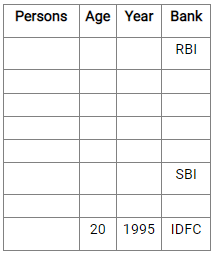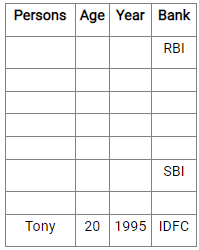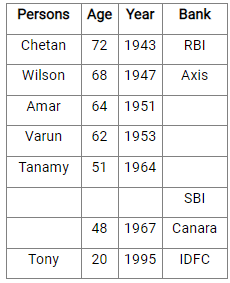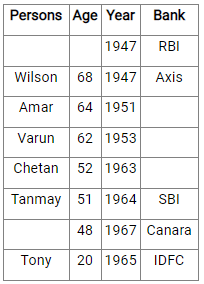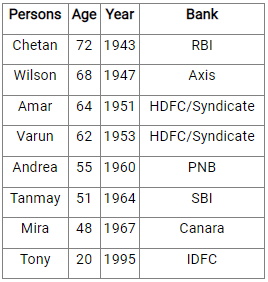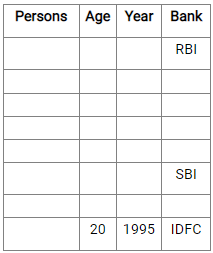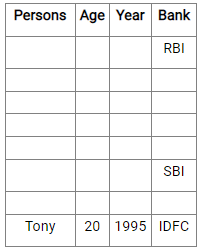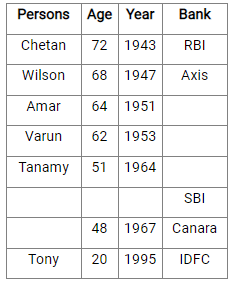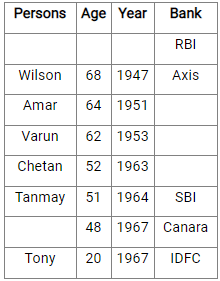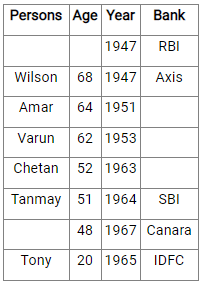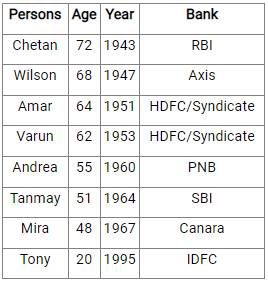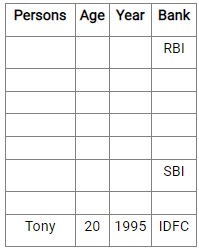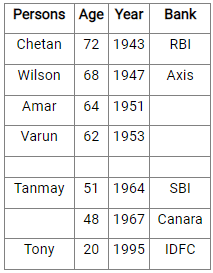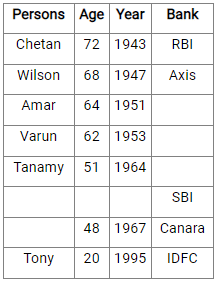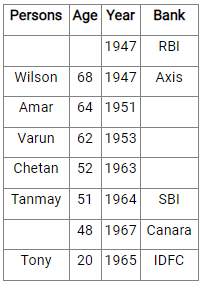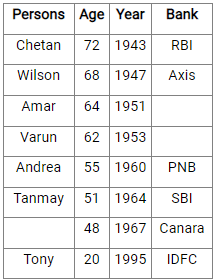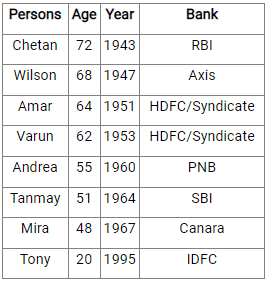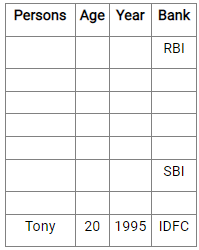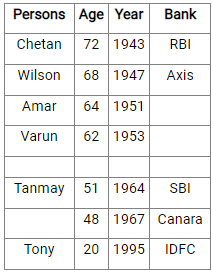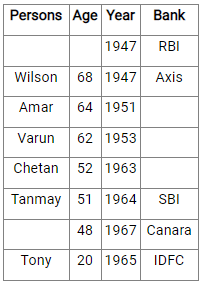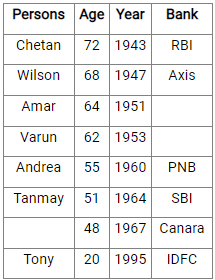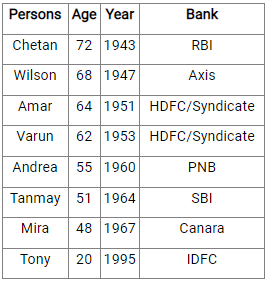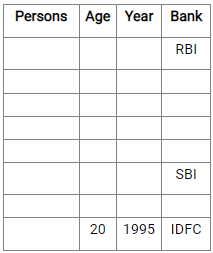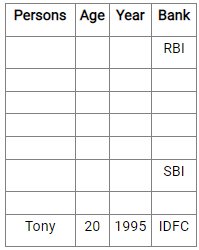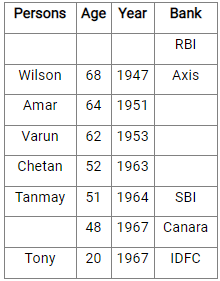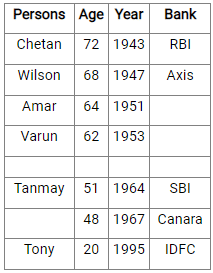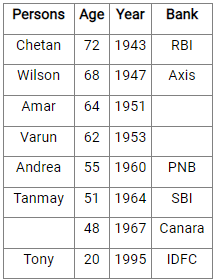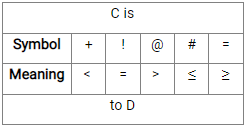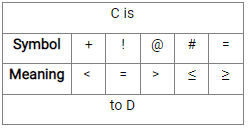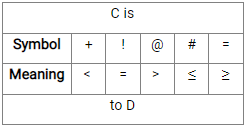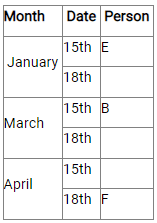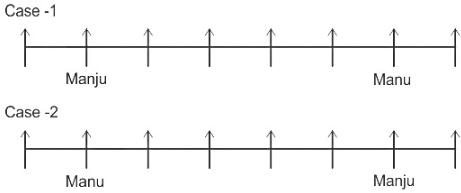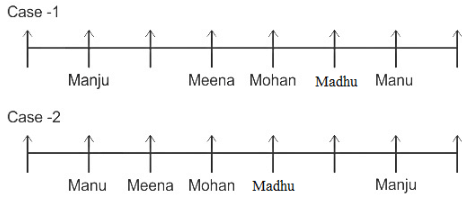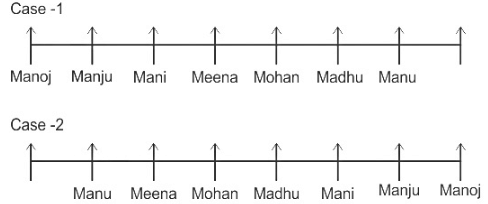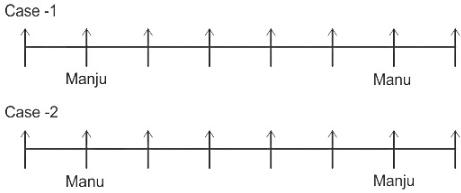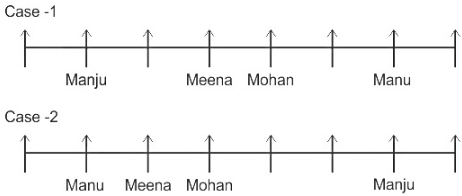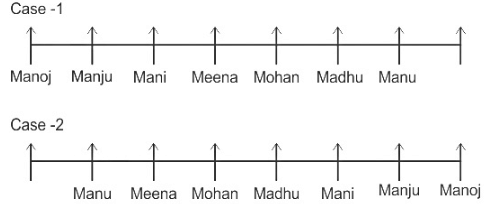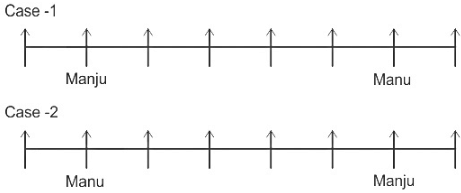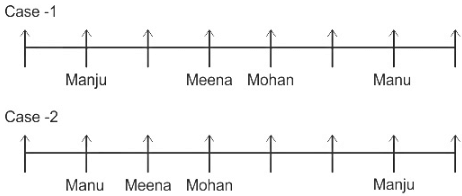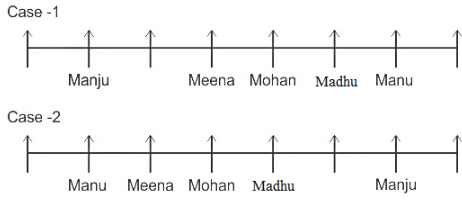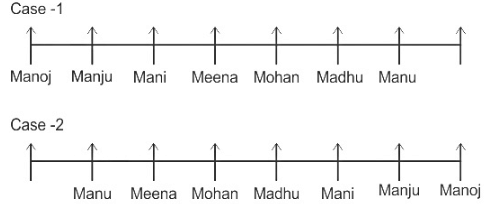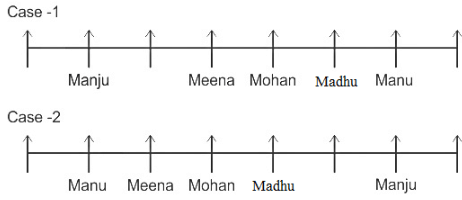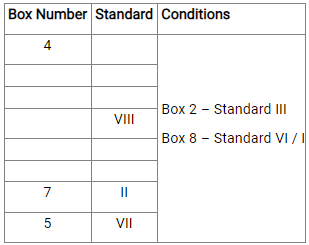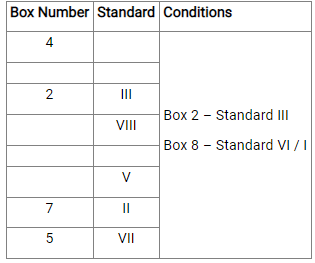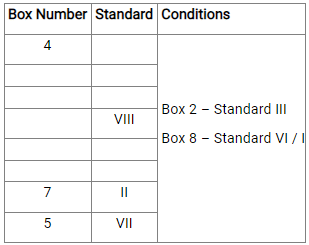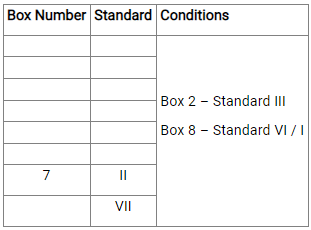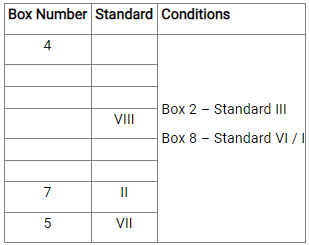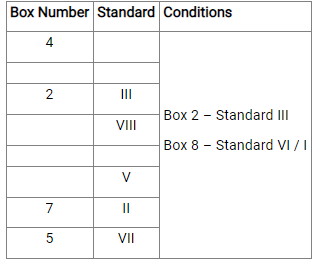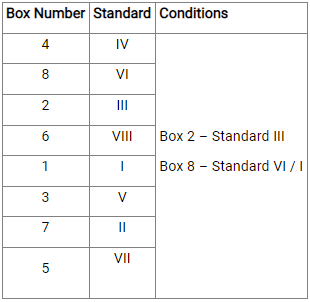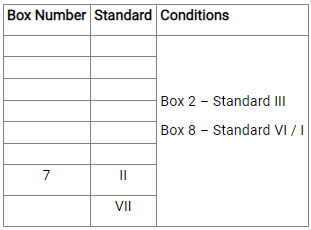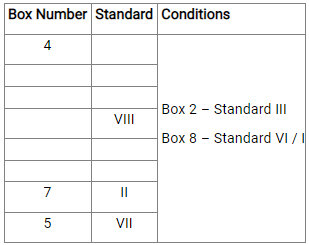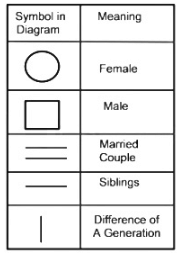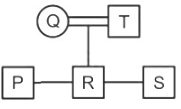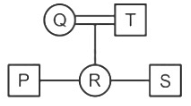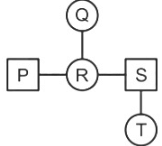IBPS RRB PO (Scale 1) Mains Mock Test - 5 - Bank Exams MCQ
30 Questions MCQ Test - IBPS RRB PO (Scale 1) Mains Mock Test - 5
Directions: Read the information carefully and answer the questions.
A family consists of eight members namely Tanmay, Chetan, Wilson, Tony, Mira, Andrea, Amar, Varun. Each works in different banks- IDFC, RBI, Axis bank, Syndicate bank, HDFC, PNB, Canara bank, SBI not necessarily in the same order. Each was born on different years, but no one was born after 1996. (Calculate all ages considering base year as 2015).
Sum of each digits of the year in which Tanmay was born is equal to age of Tony. Age of the person who works in Canara is one more than the last two digit of the year in which Wilson was born. Wilson who works in Axis bank is four years elder to Amar. Only two persons are younger to the person who works in SBI. Age of Amar is equal to last two digits of birth year of Tanmay. Andrea works in PNB and her age is multiple of 11. The person who works in IDFC bank was born after 1994 and is younger to Varun. Age of Varun is two more than the thrice of age of Tony. Amar was born two years before Varun was born. Only one person was born between the persons who work in PNB and Canara Bank. The person who works in RBI is eldest among them. Difference of ages of Chetan and Varun is 10 and tony is the youngest.
Q. What is the age of Tanmay?
Directions: Read the information carefully and answer the questions.
A family consists of eight members namely Tanmay, Chetan, Wilson, Tony, Mira, Andrea, Amar, Varun. Each works in different banks- IDFC, RBI, Axis bank, Syndicate bank, HDFC, PNB, Canara bank, SBI not necessarily in the same order. Each was born on different years, but no one was born after 1996. (Calculate all ages considering base year as 2015).
Sum of each digits of the year in which Tanmay was born is equal to age of Tony. Age of the person who works in Canara is one more than the last two digit of the year in which Wilson was born. Wilson who works in Axis bank is four years elder to Amar. Only two persons are younger to the person who works in SBI. Age of Amar is equal to last two digits of birth year of Tanmay. Andrea works in PNB and her age is multiple of 11. The person who works in IDFC bank was born after 1994 and is younger to Varun. Age of Varun is two more than the thrice of age of Tony. Amar was born two years before Varun was born. Only one person was born between the persons who work in PNB and Canara Bank. The person who works in RBI is eldest among them. Difference of ages of Chetan and Varun is 10 and tony is the youngest.
Q. Who works in RBI bank?
Directions: Read the information carefully and answer the questions.
A family consists of eight members namely Tanmay, Chetan, Wilson, Tony, Mira, Andrea, Amar, Varun. Each works in different banks- IDFC, RBI, Axis bank, Syndicate bank, HDFC, PNB, Canara bank, SBI not necessarily in the same order. Each was born on different years, but no one was born after 1996. (Calculate all ages considering base year as 2015).
Sum of each digits of the year in which Tanmay was born is equal to age of Tony. Age of the person who works in Canara is one more than the last two digit of the year in which Wilson was born. Wilson who works in Axis bank is four years elder to Amar. Only two persons are younger to the person who works in SBI. Age of Amar is equal to last two digits of birth year of Tanmay. Andrea works in PNB and her age is multiple of 11. The person who works in IDFC bank was born after 1994 and is younger to Varun. Age of Varun is two more than the thrice of age of Tony. Amar was born two years before Varun was born. Only one person was born between the persons who work in PNB and Canara Bank. The person who works in RBI is eldest among them. Difference of ages of Chetan and Varun is 10 and tony is the youngest.
Q. How many among them were born after 1990?
Directions: Read the information carefully and answer the questions.
A family consists of eight members namely Tanmay, Chetan, Wilson, Tony, Mira, Andrea, Amar, Varun. Each works in different banks- IDFC, RBI, Axis bank, Syndicate bank, HDFC, PNB, Canara bank, SBI not necessarily in the same order. Each was born on different years, but no one was born after 1996. (Calculate all ages considering base year as 2015).
Sum of each digits of the year in which Tanmay was born is equal to age of Tony. Age of the person who works in Canara is one more than the last two digit of the year in which Wilson was born. Wilson who works in Axis bank is four years elder to Amar. Only two persons are younger to the person who works in SBI. Age of Amar is equal to last two digits of birth year of Tanmay. Andrea works in PNB and her age is multiple of 11. The person who works in IDFC bank was born after 1994 and is younger to Varun. Age of Varun is two more than the thrice of age of Tony. Amar was born two years before Varun was born. Only one person was born between the persons who work in PNB and Canara Bank. The person who works in RBI is eldest among them. Difference of ages of Chetan and Varun is 10 and tony is the youngest.
Q. Mira works in which of the following bank?
Directions: Read the information carefully and answer the questions.
A family consists of eight members namely Tanmay, Chetan, Wilson, Tony, Mira, Andrea, Amar, Varun. Each works in different banks- IDFC, RBI, Axis bank, Syndicate bank, HDFC, PNB, Canara bank, SBI not necessarily in the same order. Each was born on different years, but no one was born after 1996. (Calculate all ages considering base year as 2015).
Sum of each digits of the year in which Tanmay was born is equal to age of Tony. Age of the person who works in Canara is one more than the last two digit of the year in which Wilson was born. Wilson who works in Axis bank is four years elder to Amar. Only two persons are younger to the person who works in SBI. Age of Amar is equal to last two digits of birth year of Tanmay. Andrea works in PNB and her age is multiple of 11. The person who works in IDFC bank was born after 1994 and is younger to Varun. Age of Varun is two more than the thrice of age of Tony. Amar was born two years before Varun was born. Only one person was born between the persons who work in PNB and Canara Bank. The person who works in RBI is eldest among them. Difference of ages of Chetan and Varun is 10 and tony is the youngest.
Q. Who works in HDFC bank?
Directions: In the following questions, the symbols +, !, @, # and = are used with the following meaning as illustrated below:
‘C + D’ means ‘C is neither greater than nor equal to D’.
‘C ! D’ means ‘C is neither smaller than nor greater than D’.
‘C @ D’ means ‘C is greater than D’.
‘C # D’ means ‘C is not greater than D’.
‘C = D’ means ‘C is either greater than or equal to D’.
Now in each of the following questions assuming the given statements to be True, find which of the conclusion/s given below them is/are definitely True?
Statements:
P = M, Y + B, M + O, T = P, Y # T
Conclusions:
I. T @ M
II. B + T
III. T ! M
Directions: In the following questions, the symbols +, !, @, # and = are used with the following meaning as illustrated below:
‘C + D’ means ‘C is neither greater than nor equal to D’.
‘C ! D’ means ‘C is neither smaller than nor greater than D’.
‘C @ D’ means ‘C is greater than D’.
‘C # D’ means ‘C is not greater than D’.
‘C = D’ means ‘C is either greater than or equal to D’.
Now in each of the following questions assuming the given statements to be True, find which of the conclusion/s given below them is/are definitely True?
Statements:
H @ I, K @ M, K = I, L @ M, L ! J
Conclusions:
I. K @ H,
II. J ! M
III. H @ M
Directions: In the following questions, the symbols +, !, @, # and = are used with the following meaning as illustrated below:
‘C + D’ means ‘C is neither greater than nor equal to D’.
‘C ! D’ means ‘C is neither smaller than nor greater than D’.
‘C @ D’ means ‘C is greater than D’.
‘C # D’ means ‘C is not greater than D’.
‘C = D’ means ‘C is either greater than or equal to D’.
Now in each of the following questions assuming the given statements to be True, find which of the conclusion/s given below them is/are definitely True?
Statements:
P + Q, V @ T, Q = T, V @ W, U = W
Conclusions:
I. W + V
II. Q @ V
III. V ! W
Directions: The question below consists of a question and two statements numbered I and II given below it. You have to decide whether the data provided in the statements are sufficient to answer the question.
There is a family of seven members. How is G related to Q?
Statement I: Q is the brother of W, who is married to his wife Z. P is married to Q. D is the niece of W, who has one son and one daughter. G and R are Cousins of D.
Statement II: W is the brother of Q, who is the husband of P. Z is the sister-in-law of Q, whose daughter is D. R is the niece of Q and G is the nephew of Q.
Directions: The question below consists of a question and two statements numbered I and II given below it. You have to decide whether the data provided in the statements are sufficient to answer the question.
Six people – Girish, Ayush, Shruthi, Pritam, Sagar and Chandan got different marks in an examination. But not necessarily in the same order. Who got the least marks?
Statement I: Neither Shruthi nor Pritam got the least marks. Sagar got more marks than Pritam and Chandan, but scored less marks than Ayush. Shruthi got more marks than Girish and Ayush, but Ayush did not score more than Girish.
Statement II: Ayush scored less than only two person. Pritam scored less than Ayush and Sagar, but more than Chandan. Girish scored more than Ayush but less than Shruthi.
Directions: The question below consists of a question and two statements numbered I and II given below it. You have to decide whether the data provided in the statements are sufficient to answer the question.
Six friends - A, B, C, D, E and F had meeting on either 15th or 18th of three different months – January, March and April. But not necessarily in the same order. Whose meeting is on March 15th?
Statement I: Four people had meeting between E and F. Two people had meeting between B and F, who did not have meeting on January 15th.
Statement II: A had meeting before D and C. D had meeting immediately before C.
Directions: Study the given question carefully and answer the question.
Eight friends – Manoj, Mani, Mohan, Manu, Manju, Meena, Madhu and Mahesh are sitting in a row and all of them are facing North. They are not necessarily seated in the same order.
Four people are sitting between Manju and Manu, but neither of them is sitting at any extreme ends of the row. Two people are sitting between Manju and Mohan, who is sitting to the immediate right of Meena. Only one person is sitting between Meena and Madhu, who is not sitting at any extreme ends of the row. Mani is sitting exactly in the middle of Mohan and Manoj. Madhu is sitting second to the left of Mahesh.
Q. Who is sitting second to the left of Mohan?
Directions: Study the given question carefully and answer the question.
Eight friends – Manoj, Mani, Mohan, Manu, Manju, Meena, Madhu and Mahesh are sitting in a row and all of them are facing North. They are not necessarily seated in the same order.
Four people are sitting between Manju and Manu, but neither of them is sitting at any extreme ends of the row. Two people are sitting between Manju and Mohan, who is sitting to the immediate right of Meena. Only one person is sitting between Meena and Madhu, who is not sitting at any extreme ends of the row. Mani is sitting exactly in the middle of Mohan and Manoj. Madhu is sitting second to the left of Mahesh.
Q. Who is sitting to the immediate left of Manju?
Directions: Study the given question carefully and answer the question.
Eight friends – Manoj, Mani, Mohan, Manu, Manju, Meena, Madhu and Mahesh are sitting in a row and all of them are facing North. They are not necessarily seated in the same order.
Four people are sitting between Manju and Manu, but neither of them is sitting at any extreme ends of the row. Two people are sitting between Manju and Mohan, who is sitting to the immediate right of Meena. Only one person is sitting between Meena and Madhu, who is not sitting at any extreme ends of the row. Mani is sitting exactly in the middle of Mohan and Manoj. Madhu is sitting second to the left of Mahesh.
Q. Who are the immediate neighbours of Manu?
Directions: Study the given question carefully and answer the question.
Eight friends – Manoj, Mani, Mohan, Manu, Manju, Meena, Madhu and Mahesh are sitting in a row and all of them are facing North. They are not necessarily seated in the same order.
Four people are sitting between Manju and Manu, but neither of them is sitting at any extreme ends of the row. Two people are sitting between Manju and Mohan, who is sitting to the immediate right of Meena. Only one person is sitting between Meena and Madhu, who is not sitting at any extreme ends of the row. Mani is sitting exactly in the middle of Mohan and Manoj. Madhu is sitting second to the left of Mahesh.
Q. Who is sitting exactly between Mani and Mohan?
Directions: Study the following information carefully to answer the given question.
In a six-letter English word (which may or may not be a meaningful English word), Q is placed between U and S. T is between P and R. P is not placed next to either S or U. R is not placed next to S.
Q. Which of the following is correct with respect to the word/s thus formed?
Directions: To answer this question, carefully study the following arrangements of letters, digits, and symbols.
Q P 5 # A 7 $ L A L % 2 Q @ 1 A J ? U R 3 * E D
How many such symbols are there in the above arrangement, each of which is immediately preceded by a number and also immediately followed by a vowel?
Directions: Study the information given below carefully and answer the question that follow.
A boy starts from a point P and walks 6 km towards south to reach point Q. He takes a left turn and walks 3 km to reach point R. He takes a left turn again and walks 12 km to reach point S. From there he takes left turn and walks 6 km and reaches point T. He takes a left turn again and walks another 6 km to reach point U. He takes a left turn and walks 5 km to reach point V.
Q. Distance between the midpoint of S and R and point V?
Directions: To answer this question, carefully study the following arrangements of letters, digits, and symbols.
Q C # 2 A 3 M $ F G % 9 1 G A C C S 5 I 8 @ V
How many such symbols are there in the above arrangement, each of which is immediately followed by a number and immediately preceded by a consonant?
Directions: Read the instructions carefully and answer the question below:
In the store room of a School, eight boxes numbered 1 to 8 are stacked one above the other but not necessarily in the same order. The stuff related to eight classes Standard I to VIII is kept in these boxes but not necessarily in the same order.
The box at the bottom of the stock contains the stuff of standard VII. The stuff of standard III is kept in the box which is numbered with even prime number. Box numbered 8 contains the stuff of either Standard VI or I. Box numbered 7 contains the stuff of Standard II and is kept immediately above the box which contains the stuff of Standard VII. The box which contains the stuff of standard VIII has kept three boxes above the box that contains the stuff of Standard II. Box numbered 4 is kept at the top of the stack. Only one box is kept between Box numbered 4 and box numbered 2. Two boxes are kept between box 2 the box that contains the stuff of Standard V. The box that contains the stuff of Standard I is kept below the box number 2. Box numbered 5 is kept below the box numbered 7. There are two boxes between box numbered 5 and box numbered 1. Box numbered 6 is kept above the box numbered 3.
Q. How many boxes are kept above box numbered 8?
Directions: Read the instructions carefully and answer the question below:
In the store room of a School, eight boxes numbered 1 to 8 are stacked one above the other but not necessarily in the same order. The stuff related to eight classes Standard I to VIII is kept in these boxes but not necessarily in the same order.
The box at the bottom of the stock contains the stuff of standard VII. The stuff of standard III is kept in the box which is numbered with even prime number. Box numbered 8 contains the stuff of either Standard VI or I. Box numbered 7 contains the stuff of Standard II and is kept immediately above the box which contains the stuff of Standard VII. The box which contains the stuff of standard VIII has kept three boxes above the box that contains the stuff of Standard II. Box numbered 4 is kept at the top of the stack. Only one box is kept between Box numbered 4 and box numbered 2. Two boxes are kept between box 2 the box that contains the stuff of Standard V. The box that contains the stuff of Standard I is kept below the box number 2. Box numbered 5 is kept below the box numbered 7. There are two boxes between box numbered 5 and box numbered 1. Box numbered 6 is kept above the box numbered 3.
Q. Four of the following pair follow a pattern thus form a group. Find the pair that does not belong to the group?
Directions: Read the instructions carefully and answer the question below:
In the store room of a School, eight boxes numbered 1 to 8 are stacked one above the other but not necessarily in the same order. The stuff related to eight classes Standard I to VIII is kept in these boxes but not necessarily in the same order.
The box at the bottom of the stock contains the stuff of standard VII. The stuff of standard III is kept in the box which is numbered with even prime number. Box numbered 8 contains the stuff of either Standard VI or I. Box numbered 7 contains the stuff of Standard II and is kept immediately above the box which contains the stuff of Standard VII. The box which contains the stuff of standard VIII has kept three boxes above the box that contains the stuff of Standard II. Box numbered 4 is kept at the top of the stack. Only one box is kept between Box numbered 4 and box numbered 2. Two boxes are kept between box 2 the box that contains the stuff of Standard V. The box that contains the stuff of Standard I is kept below the box number 2. Box numbered 5 is kept below the box numbered 7. There are two boxes between box numbered 5 and box numbered 1. Box numbered 6 is kept above the box numbered 3.
Q. How many boxes are numbered same as the class to which the stuff inside the box belongs?
Directions: Read the instructions carefully and answer the question below:
In the store room of a School, eight boxes numbered 1 to 8 are stacked one above the other but not necessarily in the same order. The stuff related to eight classes Standard I to VIII is kept in these boxes but not necessarily in the same order.
The box at the bottom of the stock contains the stuff of standard VII. The stuff of standard III is kept in the box which is numbered with even prime number. Box numbered 8 contains the stuff of either Standard VI or I. Box numbered 7 contains the stuff of Standard II and is kept immediately above the box which contains the stuff of Standard VII. The box which contains the stuff of standard VIII has kept three boxes above the box that contains the stuff of Standard II. Box numbered 4 is kept at the top of the stack. Only one box is kept between Box numbered 4 and box numbered 2. Two boxes are kept between box 2 the box that contains the stuff of Standard V. The box that contains the stuff of Standard I is kept below the box number 2. Box numbered 5 is kept below the box numbered 7. There are two boxes between box numbered 5 and box numbered 1. Box numbered 6 is kept above the box numbered 3.
Q. Which box contains stuff of standard VIII?
Directions: Study the following information carefully to answer the given questions:
If 'A + B' means 'A is the brother of B'
If 'A $ B' means 'A is the sister of B'
If 'A % B' means 'A is the son of B'
If 'A & B' means 'A is the father of B'
If 'A # B' means 'A is the mother of B'
Q. How is K related to E in the expression 'K & S + L # Z % E & Q’?
Directions: Study the following information carefully to answer the given questions:
If 'A + B' means 'A is the brother of B'
If 'A $ B' means 'A is the sister of B'
If 'A % B' means 'A is the son of B'
If 'A & B' means 'A is the father of B'
If 'A # B' means 'A is the mother of B'
Q. Which of the given expressions indicates that Q is the grandmother of T?
Directions: Study the information given below carefully and answer the question that follow.
A boy starts from a point P and walks 6 km towards south to reach point Q. He takes a left turn and walks 3 km to reach point R. He takes a left turn again and walks 12 km to reach point S. From there he takes left turn and walks 6 km and reaches point T. He takes a left turn again and walks another 6 km to reach point U. He takes a left turn and walks 5 km to reach point V.
Q. Distance between the start point and end point is?
Directions: Read the following information carefully and answer the questions that follow:
Six persons namely Ram, Rakesh, Ramesh, Roja, Rekha, and Rajan are getting different salaries but not necessarily in the same order. Rekha gets more than Roja and Rajan. Ram gets Rs 5,000 more than Roja. Ramesh gets more than Rajan, who gets the least salary. The highest salary getting person gets Rs 50,000. Ram gets less than Rekha, who is not the highest salary getting person. Roja gets more than Rakesh and gets Rs 15,000.
Q. How many persons gets salary more than Roja?
Directions: Read the following information carefully and answer the questions that follow:
Six persons namely Ram, Rakesh, Ramesh, Roja, Rekha, and Rajan are getting different salaries but not necessarily in the same order. Rekha gets more than Roja and Rajan. Ram gets Rs 5,000 more than Roja. Ramesh gets more than Rajan, who gets the least salary. The highest salary getting person gets Rs 50,000. Ram gets less than Rekha, who is not the highest salary getting person. Roja gets more than Rakesh and gets Rs 15,000.
Q. Who gets second lowest salary?
How many pairs of letters are there in the word “FOLLOWING” which have as many letters between them as in the English alphabetical series (Both in forward and backward direction)?
Directions: The question consists of two statements, an assertion and a reason. The student must first determine whether each statement is true. Choose the appropriate option, after reading the two statements carefully.
Assertion (A): Rabid animals are euthanized by animal control.
Reason (R): Rabies is highly contagious, and affects the central nervous system of humans and other mammals.


